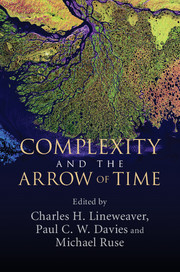Book contents
- Frontmatter
- Contents
- Author biographies
- Part I Introduction
- Part II Cosmological and physical perspectives
- Part III Biological complexity, evolution, and information
- Part IV Philosophical perspectives
- 12 Wrestling with biological complexity: from Darwin to Dawkins
- 13 The role of generative entrenchment and robustness in the evolution of complexity
- 14 On the plurality of complexity- producing mechanisms
- Index
- References
14 - On the plurality of complexity- producing mechanisms
from Part IV - Philosophical perspectives
Published online by Cambridge University Press: 05 July 2013
- Frontmatter
- Contents
- Author biographies
- Part I Introduction
- Part II Cosmological and physical perspectives
- Part III Biological complexity, evolution, and information
- Part IV Philosophical perspectives
- 12 Wrestling with biological complexity: from Darwin to Dawkins
- 13 The role of generative entrenchment and robustness in the evolution of complexity
- 14 On the plurality of complexity- producing mechanisms
- Index
- References
Summary
When you stir your rice pudding, Septimus, the spoonful of jam spreads itself round making red trails like the picture of a meteor in my astronomical atlas. But if you stir backwards, the jam will not come together again. Indeed, the pudding does not notice and continues to turn pink just as before. Do you think this is odd?
If knowledge isn't self-knowledge it isn't doing much, mate. Is the universe expanding? Is it contracting? Is it standing on one leg and singing ‘When Father Painted the Parlour’? Leave me out. I can expand my universe without you. ‘She walks into beauty, like the night of cloudless climes and starry skies, and all that's best of dark and bright meet in her aspect and her eyes.’
Tom Stoppard, ArcadiaIt might seem obvious that the universe becomes more complex over time. After all, isn't a gas cloud consisting only of hydrogen and helium a few seconds after the big bang simpler than a cloud of hydrogen, helium, carbon, silicon, and oxygen two billion years later? Aren't the dynamics of a system at the level of particle physics simpler than the dynamics of a group of interacting cells?
As intuitive as these proposals are, we don't currently possess an adequate quantitative measure of the increase or decrease in complexity either across cosmic evolution or across scientific disciplines. In the past, many theorists presupposed that the gap between actual entropy and maximum entropy is not permanent, that heat death will win in the end. These theorists were eager to link complexity in a quantitative way to this “entropy gap”, so that the two would rise and fall together. Others now argue that, in an expanding universe, the maximum possible entropy will increase more quickly than actual entropy, casting the “heat death” hypothesis into question.
- Type
- Chapter
- Information
- Complexity and the Arrow of Time , pp. 332 - 351Publisher: Cambridge University PressPrint publication year: 2013
References
- 2
- Cited by



